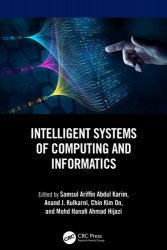 Название: Intelligent Systems of Computing and Informatics
Название: Intelligent Systems of Computing and InformaticsАвтор: Samsul Ariffin Abdul Karim, Anand J. Kulkarni, Chin Kim On
Издательство: CRC Press
Год: 2024
Страниц: 354
Язык: английский
Формат: pdf (true)
Размер: 14.3 MB
Since 2011, the Fourth Industrial Revolution (IR4.0) has played a significant role in education, research, and industry. There are nine pillars under the framework of IR4.0 namely Big Data and Analytics, Robotics, Simulation, Horizontal and Vertical Integration, Internet of Things (IoT), Cybersecurity, Cloud Computing, Additive Manufacturing and Augmented Reality. Besides, data technologies have been evolving rapidly to cater the rapid growing size of the data as well as to enhance the security of the shared data through multiple resources and platforms. Machine Learning, IoT, simulation and cloud computing are the mainstream tools to develop an up-to-date Intelligent Systems of Computing and Informatics (ISCI). This new system can be used to produce the desired outcome for the industries through efficient computational intelligence techniques as well as software development. The developments of ISCI are significant as they will enable the related agencies and policy-makers to conduct the quick and reliable self-decision-making involving complex processes in the fields of engineering and computer sciences.
Comprising 20 chapters by experts from all over the world, this book covers such topics as data technologies, Machine Learning, signal and image processing, software systems efficiency, computer networking, Internet of Things, and computational intelligence for real-life problems.
The main topics covered in this book are:
• Machine Learning
• Big Data and data analytics
• Computer networking and IoT
• Software systems efficiency
• Data processing algorithms and applications
• Signal and image processing
• Modeling and simulation via fast algorithm
• Computational intelligence and statistics
Malware include viruses, worms, Trojans, ransomware, spyware, adware, and rootkits, created for harmful purposes like stealing data or disrupting systems. Fighting malware is vital for cybersecurity due to its wide-ranging forms and impacts. These attributes help identify whether software is malware. In this chapter, the malware datasets are scrutinized through the use of virtual instances. To assess the impacts of these malware, they are executed securely within a virtual environment. The benign dataset is obtained by gathering executable programs designed for the running virtual Windows 10 environment. This dataset typically consists of harmless software or files that are used as a reference or comparison in the experiment. These programs are not considered malware and are used to establish a baseline for normal system behavior. By contrasting the behavior of potentially malicious software with the benign dataset, malware program can be identified and detected more effectively.
Malware and benign program classification is widely carried out using classical Machine Learning algorithms like k-nearest neighbors (kNN), support vector machine (SVM), decision tree, Naive Bayes (NB), and stochastic gradient descent (SGD). In addition, ensemble algorithms based on Bagging techniques, including standard bagging with DT as the base estimator (bagging-DT), random forest, and extra trees, are employed. Furthermore, ensemble algorithms utilizing Boosting methods, such as AdaBoost, Gradient Boosting Machine (GBM), XGBoost, LightGBM, and CatBoost, are also applied. Ensemble algorithms based on Voting classifier and Stacking generalization are also employed. Given that the distribution of samples between benign and malware classes in malware classification often suffers from an imbalance, this study also explores modified ensemble algorithms designed to address such issues. These modified algorithms include bagging with random undersampling (bagging-RU), random forest with class weighting (RF-W), and random forest with random under-sampling (RF-U).
This book is highly suitable for postgraduate students, researchers working in various Research and Development (R&D) agencies, practitioners, policymakers as well as scientists that have an interest in Intelligent Systems of Computing and Informatics towards IR4.0.
Скачать Intelligent Systems of Computing and Informatics